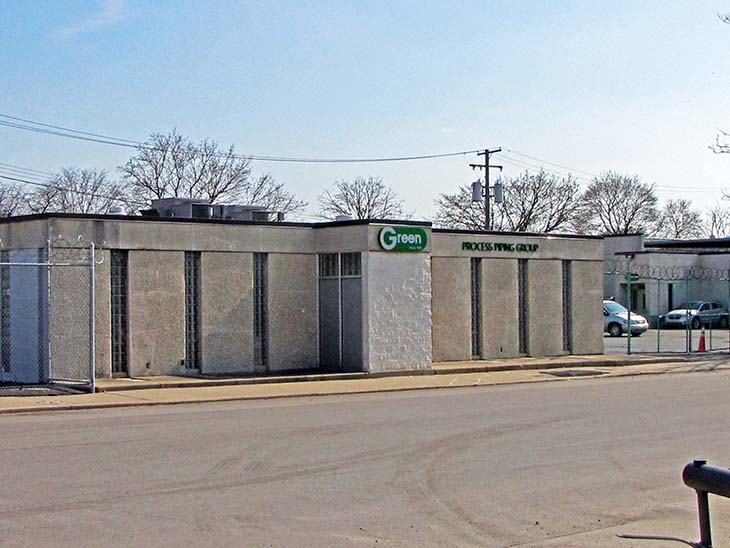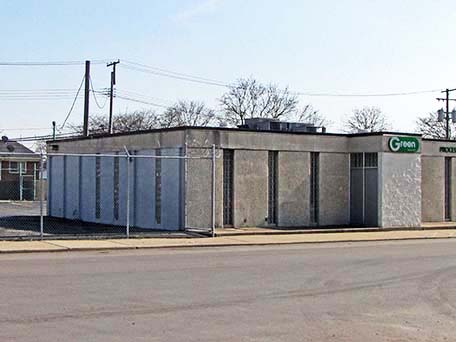

There is no historical marker at this site. Perhaps there should be since this location is, arguably, the site of the first building in the United States constructed by Muslims to use as a mosque consistent with the architectural traditions of that faith. By 1900 or so, quite a few Turkish and Kurdish Muslims were escaping from the Ottoman Empire to get away from conscription, political turmoil and the lack of economic opportunities. Young people also left Syria for similar reasons. For the most part they were men since they were at risk of conscription. A few of them made their way to the United States early in the 1900s. New York, Boston and New Orleans were their ports of arrival. Some of them heard about the emergence of the vehicle industry in Detroit and came seeking employment. During World War I, quite a few Bangladeshi Muslims also came to Detroit to take defense industry jobs.
Henry Ford opened his Highland Park plant in 1910—a plant that played an important role in changing the culture and economic structure of the nation and the world since it was where the mass production of cars was perfected. Ford, however, had difficult time finding men who could withstand the rigors of working there; hence, his initiation of a $5 per day pay scale in 1914. Apparently, by that time several blocks of Labelle and Victor avenues in Highland Park had numerous residents who were immigrants from the Ottoman Empire, Syria and other points in the eastern Mediterrean. Some of them were Christians. St. Maron Maronite Church—now located at the intersection of Kercheval and St. Jean on the far east side of Detroit – dates from 1909 and St. George’s Antiochian Orthodox parish dates from 1918. The parish church of St. George Antiochian is now located at 2160 East Maple Road in Troy.
Three brothers, Mohammed, Hussein and Osman Karob, migrated from Damascus to th e United States about 1912. They worked as farm laborers in Connecticut but then heard about Henry Ford’s need for workers and moved to Highland Park for the higher wages. Mohammed Karob assembled Fords for some time but quickly realized that there was a fortune to be made in real estate investments in the booming Detroit area. Apparently, he became prosperous. He believed that the growing Muslim community needed a mosque. Using his own funds, he purchased land for a mosque at 242 Victor Avenue, less than 100 yards from the massive Ford Highland Park plant and commissioned architect Theodore Degenhardt to design the structure. The first floor of the mosque was devoted to worship while the second floor provided space for teaching Arabic and the Muslim faith. The Islamic tradition specifies a number of architectural features for a mosque and, I believe, that they were incorporated in this building to the extent possible. The finials on the dome and the minarets were pointed toward Mecca. June 8, 1921 was the date of the grand opening of the Moslem Mosque of Highland Park.
e United States about 1912. They worked as farm laborers in Connecticut but then heard about Henry Ford’s need for workers and moved to Highland Park for the higher wages. Mohammed Karob assembled Fords for some time but quickly realized that there was a fortune to be made in real estate investments in the booming Detroit area. Apparently, he became prosperous. He believed that the growing Muslim community needed a mosque. Using his own funds, he purchased land for a mosque at 242 Victor Avenue, less than 100 yards from the massive Ford Highland Park plant and commissioned architect Theodore Degenhardt to design the structure. The first floor of the mosque was devoted to worship while the second floor provided space for teaching Arabic and the Muslim faith. The Islamic tradition specifies a number of architectural features for a mosque and, I believe, that they were incorporated in this building to the extent possible. The finials on the dome and the minarets were pointed toward Mecca. June 8, 1921 was the date of the grand opening of the Moslem Mosque of Highland Park.
At the start, the mosque, I believe, welcomed Ahmadi, Shiite and Sunni Muslims but the congregation was not very unified. I infer that there were bitter disagreements among those who were involved in developing this mosque from a very early point. Mohammed Karob was seen by some as heavy handed and dominating. He was, after all, the donor who “created” the mosque. Religious communities are often split by such bitter controversies. By 1922, the number of worshipers declined sharply. Syrian Muslims, instead of moving to Highland Park, were migrating to Dearborn to live closer to Ford’s River Rouge plant. Karob apparently got discouraged about the issues and tried to sell the mosque but there was much controversy about that also and conflict with those who disagreed with him. Indeed, in 1924, Mohammed Karob was charged with murder of one of his rivals in the Highland Park Muslim community but was acquitted at trial. He sold the mosque to the city of Highland Park in 1926. The city, in turn, sold it to a fraternal organization: Woodman of the World. The area along Victor Avenue is now lined with small machine shops and other facilities that once serviced the huge nearby Ford Highland Park plant. Despite the short life of this mosque, it may have been a model for the building of other mosques in the 1920s by Muslim communities in Cedar Rapids, Iowa; Ross, North Dakota and Dearborn.
The original mosque built in the United States was, apparently, constructed for the Columbian Exposition in Chicago for the summer of 1893. This was not constructed by a community of the faithful, but rather, was a component of that World’s Fair. It was designed to both welcome Muslim tourists—of which there were few—and remind visitors of the Islamic faith. It was torn down shortly after the fair ended in October, 1893. A modest number of Albanian Muslims settled in Biddeford, Maine early in the Twentieth Century. That town was booming as numerous textile mills needed workers. Those Albanian Muslims built a multiple purpose structure in 1915 so it was not specifically a mosque but I can understand how Biddeford boosters would claim to have the first mosque. Following the example of Highland Park, the Islamic community of Ross, North Dakota built a mosque that opened in 1929. This is often cited as the first mosque in the United States, perhaps because of the very short and controversial lifespan of the Highland Park mosque. A mosque that opened in 1934 in
Cedar Rapids, Iowa now claims the title of Mother Mosque of America but that is not quite the same as being the first mosque in the country. It is, however, the oldest standing mosque in the nation that has continuously been used for worship.
Date of Construction: 1921
Architect: Theodore Degenhardt
Use of the land in 2016: Corporate office of the John E. Green Company, a mechanical contractor.
State of Michigan Registry of Historic Places: Not listed
National Register of Historic Sites: Not listed
Book detailing history of the mosque: Sally Howell, Old Islam in Detroit: Rediscovering the Muslim American Past. New York: Oxford University Press, 2014
Picture: Ren Farley; April 17, 2015
Description updated: October, 2016
Return to Religious Structures
Return to Homepage